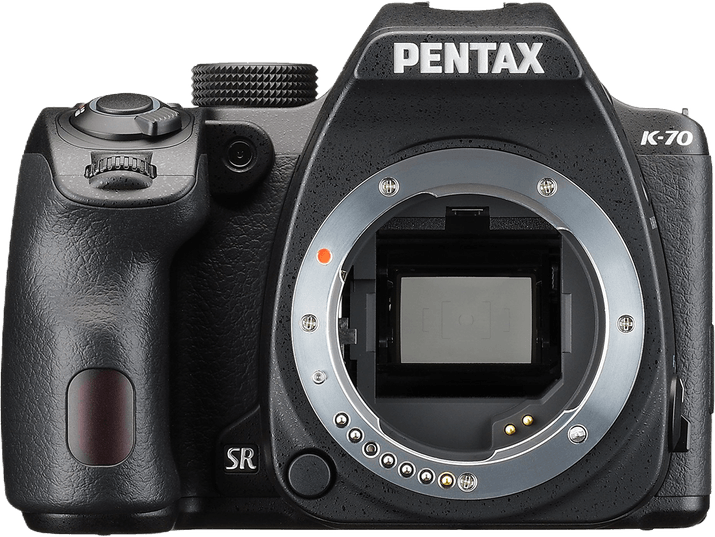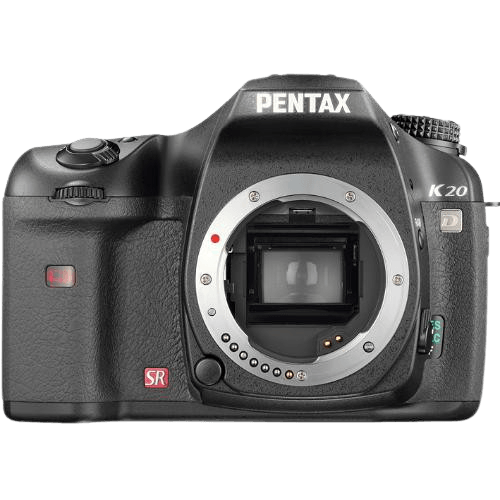Pentax K-70 vs K20D Comparison
Pentax K-70

Pentax K20D

The Pentax K-70 outperforms the Pentax K20D with a score of 69/100 compared to the K20D’s 47/100. Both cameras are DSLRs with similar launch prices, the K-70 at $650 and the K20D at $770. They share common specifications, such as camera type and dimensions, with the K-70 measuring 126 x 93 x 74mm and the K20D at 142 x 101 x 70mm.
The K-70 excels due to its more recent release in 2016, making it a more advanced camera than the K20D, which was released in 2008. Additionally, the K-70 is lighter, weighing 688g compared to the K20D’s 800g, making it more comfortable to carry and use.
On the other hand, the K20D has a slightly smaller depth, which could be a minor advantage for some users. However, this difference is negligible when considering the overall performance and advancements of the K-70. The Pentax K-70 is undoubtedly the superior option, offering better specifications and a higher score, making it the clear winner in this comparison.
Pentax K-70 vs K20D Overview and Optics
The Pentax K-70 emerges as the winner in this comparison, scoring 74 out of 100 in optics, while the Pentax K20D scores 49. Both cameras share some common specifications: they both have a CMOS sensor, APS-C sensor size, Pentax lens mount, and image stabilization.
The Pentax K-70 exceeds the K20D in several aspects. It has a higher megapixel count of 24 compared to the K20D’s 14.6, allowing for more detailed and higher resolution images. The K-70 also boasts a faster shooting speed of 6 frames per second, doubling the K20D’s 3 frames per second. This faster shooting speed enables the K-70 to capture fast-moving subjects more effectively. Additionally, the K-70’s Prime MII image processor outperforms the K20D’s Prime processor, providing better image quality and faster processing times. Lastly, the K-70 has a higher DXOMARK sensor score of 88, compared to the K20D’s 65, indicating superior sensor performance.
The Pentax K20D does not have any specific advantages over the K-70 in terms of optics. However, it is important to note that the K20D still offers decent image quality and performance for its age.
Considering the significant differences in optics scores and the advantages of the K-70, it is clear that the Pentax K-70 is the superior camera in this comparison. The K-70’s higher megapixel count, faster shooting speed, advanced image processor, and better sensor performance make it a more powerful and versatile camera. On the other hand, the Pentax K20D, while not as impressive as the K-70, remains a viable option for those seeking a more affordable camera with decent performance.
Pentax K-70 vs K20D Video Performance
When comparing the video capabilities of the Pentax K-70 and the Pentax K20D, it is important to note that the Pentax K20D does not have any video functionality. This means that if video recording is a priority, the K20D would not be a suitable choice. On the other hand, the Pentax K-70 offers a range of video features that make it a more versatile option for those interested in capturing both still images and video footage.
The Pentax K-70 has a video score of 70 out of 100, indicating its decent performance in this category. Its maximum video resolution is Full HD, with dimensions of 1920 x 1080 pixels. This ensures that the K-70 can capture high-quality video footage suitable for various purposes. Additionally, the K-70 has a maximum video frame rate of 60 frames per second, allowing for smoother motion capture and better results when filming fast-moving subjects or scenes. Furthermore, the K-70 has built-in time-lapse functionality, which enables users to create stunning time-lapse videos with ease.
Taking into consideration the video capabilities of both cameras, it is clear that the Pentax K-70 is the better option for those who require video recording features. The K20D’s lack of video functionality makes it a less versatile choice, while the K-70’s range of video features, including Full HD resolution, 60fps frame rate, and built-in time-lapse, make it a more suitable camera for users interested in both photography and videography.
Pentax K-70 vs K20D Features and Benefits
The Pentax K-70 is the winner in this comparison, scoring 68 out of 100 for features, while the Pentax K20D scores 47 out of 100. Both cameras share some specifications, such as the absence of a touchscreen. However, the K-70 outperforms the K20D in several aspects, making it the better camera.
The Pentax K-70 and K20D have different screen sizes and resolutions. The K-70 has a 3-inch screen with a resolution of 921,000 dots, while the K20D has a 2.7-inch screen with a resolution of 230,000 dots. The K-70’s larger screen and higher resolution provide a clearer and more detailed display.
The K-70 also has a flip screen, enabling users to shoot from various angles and capture creative shots easily. This feature is not present in the K20D. Additionally, the K-70 is equipped with GPS, WIFI, and Bluetooth, which are lacking in the K20D. These features make the K-70 more versatile and convenient for modern photography needs.
On the other hand, the K20D does not surpass the K-70 in any particular feature. The K-70 is simply a more advanced and feature-rich camera compared to the K20D. This is reflected in their respective feature scores.
Taking these points into consideration, the Pentax K-70 is the superior camera in terms of features. Its larger and higher resolution screen, flip screen, and connectivity options give it a clear advantage over the K20D. The K20D, while a decent camera, does not offer any significant benefits over the K-70. Therefore, the K-70 is the recommended choice for photographers seeking a camera with more advanced features.
Pentax K-70 vs K20D Storage and Battery
The Pentax K20D wins the storage and battery comparison with a score of 27, while the Pentax K-70 scores 24. Both cameras have a single memory card slot and do not support USB charging. They accept SD and SDHC memory cards, with the K-70 also accepting SDXC (UHS-I compatible) cards, and the K20D accepting MMC cards.
The K20D’s advantage lies in its longer battery life, providing 500 shots compared to the K-70’s 410 shots. This makes the K20D more suitable for extended shooting sessions without needing to change the battery. The K-70, on the other hand, offers compatibility with faster and higher capacity SDXC cards, allowing for quicker transfer speeds and more storage for photos and videos.
Considering these factors, the K20D’s longer battery life gives it an edge in this comparison, while the K-70’s support for SDXC cards provides some benefits in storage capacity and transfer speeds.
Pentax K-70 vs K20D – Our Verdict
Are you still undecided about which camera is right for you? Have a look at these popular comparisons that feature the Pentax K-70 or the Pentax K20D:

